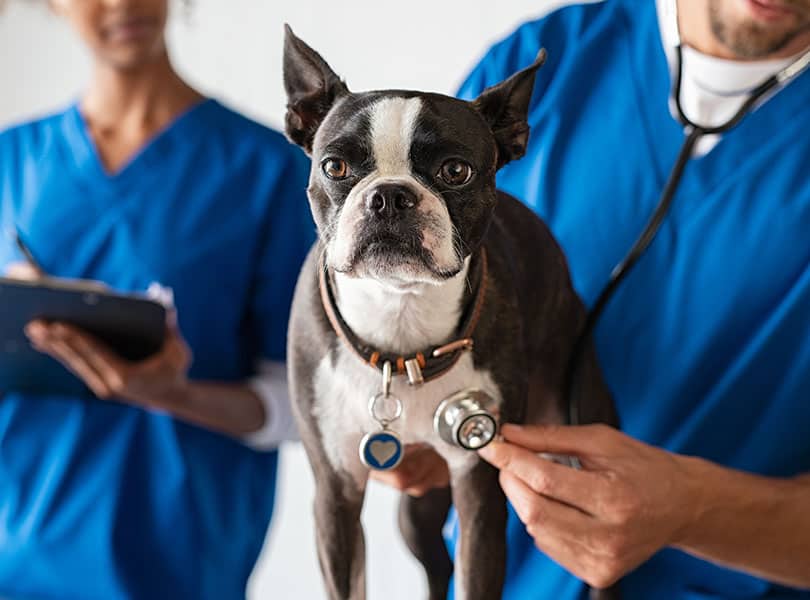The Function of Ultrasound and CT Check in Modern Veterinary Practices: Insights From Experienced Professionals
In contemporary veterinary practices, ultrasound and CT scans significantly enhance diagnostic capabilities. These imaging techniques provide critical insights right into animal wellness, assisting treatment decisions. Experienced specialists acknowledge the one-of-a-kind advantages of each method. Ultrasound provides real-time assessments, while CT checks deliver intricate anatomical details. Comprehending their applications and functions increases crucial concerns regarding their effect on person end results and the future of vet diagnostics. What understandings can be gotten from their incorporated use?
Recognizing Ultrasound in Vet Medicine
Ultrasound is a vital diagnostic tool in veterinary medicine, providing a non-invasive technique to imagine inner structures. This imaging strategy utilizes high-frequency sound waves to produce real-time pictures of cells and body organs, permitting vets to assess conditions without medical intervention. Usual applications consist of assessing the heart, liver, kidneys, and reproductive body organs, as well as monitoring pregnancies.The procedure is relatively fast and can be executed in various setups, making it an accessible alternative for vets. Unlike radiography, ultrasound gives comprehensive info regarding soft cells and blood circulation, which is important for precise diagnoses.Veterinary professionals rely upon ultrasound to identify abnormalities such as lumps, cysts, and fluid buildup. Its ability to guide biopsies and various other treatments further enhances its utility in medical practice. By offering a reliable and safe method to examine interior composition, ultrasound has actually ended up being a keystone of contemporary vet diagnostics.
The Benefits of CT Scans for Pet Diagnostics
CT scans offer considerable benefits in vet diagnostics by providing improved precision in identifying interior problems (Ultrasound For Dogs). As a non-invasive imaging method, they assure the safety and security and convenience of pets during assessments. On top of that, CT checks facilitate a detailed assessment of internal structures, permitting a lot more reliable therapy planning
Improved Diagnostic Accuracy
Improvements in imaging modern technology have actually substantially improved analysis accuracy in veterinary medication, specifically via making use of CT scans. These scans provide comprehensive cross-sectional photos of an animal's interior structures, enabling veterinarians to identify abnormalities with precision. The high resolution and three-dimensional capabilities of CT imaging facilitate the detection of problems such as lumps, cracks, and interior bleeding that may be missed out on with traditional imaging methods. In addition, CT scans can aid in pre-surgical preparation by using an extensive view of physiological connections. This level of information not just enhances the accuracy of medical diagnoses however likewise aids in customizing efficient treatment strategies. Subsequently, the combination of CT technology right into vet practices is changing the landscape of animal healthcare, boosting results for patients.
Non-Invasive Imaging Method
The introduction of non-invasive imaging strategies has revolutionized animal diagnostics, with CT checks emerging as a noticeable tool in vet practices. These scans give high-resolution, cross-sectional photos of a pet's internal structures, permitting veterinarians to examine complex problems without the demand for invasive treatments. The advantages of CT scans include their ability to identify growths, cracks, and internal bleeding with impressive precision. In addition, they help with the examination of soft cells and organs, improving analysis capacities. The speed of CT scanning allows fast decision-making, which is essential in emergency circumstances. By lessening stress and anxiety and discomfort for the pet, CT scans add to a much more humane strategy to diagnostics, inevitably improving treatment results and progressing vet treatment.
Comprehensive Internal Analysis
A thorough internal evaluation is vital for exact medical diagnosis and reliable therapy in vet medication. CT checks deal substantial benefits hereof, giving detailed cross-sectional images of an animal's internal frameworks. This innovative imaging technique boosts visualization of intricate physiological areas, making it possible for vets to determine irregularities such as growths, fractures, and interior bleeding with greater accuracy. In enhancement, CT checks assist in the evaluation of conditions that may be testing to identify with standard techniques. The rate and accuracy of CT imaging additionally add to prompt interventions, enhancing client outcomes. As veterinary practices increasingly integrate CT technology, the benefits of considerable interior analyses become apparent, strengthening the relevance of this tool in modern-day veterinary diagnostics.
Contrasting Ultrasound and CT Imaging Techniques
While both ultrasound and CT imaging offer essential functions in vet diagnostics, each method supplies distinct advantages and limitations that can affect professional decision-making. Ultrasound is especially valued for its real-time imaging abilities, permitting veterinarians to observe vibrant physical procedures. This method is non-invasive, mobile, and does not involve ionizing radiation, making it a safer option for both medical professionals and animals. Nevertheless, ultrasound may have restrictions in envisioning specific physiological frameworks or deep tissues.Conversely, CT imaging gives comprehensive cross-sectional views of the body, enabling for precise localization of abnormalities. It masters assessing facility body organs and structures, particularly in the thorax and abdominal area. Nevertheless, CT scans require sedation or anesthetic in a lot of cases and include exposure to ionizing radiation. Ultimately, the selection between ultrasound and CT depends upon the details professional scenario, the area of passion, and the necessity of the analysis requirements.
Case Researches: Successful Diagnoses Via Imaging
Case studies illustrate the considerable renovations in diagnostic precision attained via innovative imaging technologies like ultrasound and CT scans in vet techniques. These innovations not only enhance the discovery of various conditions yet additionally help with timely and reliable therapy plans. Examining specific situations can highlight the transformative influence of these imaging strategies on veterinary medication.
Diagnostic Precision Improvements

Imaging Modern Technology Advancements
As vet imaging modern technology remains to evolve, its impact on analysis capabilities becomes increasingly evident. Current study highlight the successful application of sophisticated ultrasound and CT scan methods in determining complicated conditions. A veterinary facility utilized high-resolution CT scans to diagnose an uncommon kind of lung cancer cells in a dog, which conventional imaging had missed. An ultrasound assessment disclosed a stomach mass in a cat, triggering prompt surgical intervention and a positive outcome. These innovations not just enhance analysis accuracy but additionally enable vets to create targeted treatment plans. By leveraging sophisticated imaging innovations, vet specialists are noticeably enhancing patient treatment, resulting in a lot more effective monitoring of different health problems in animals.
The Role of Imaging in Emergency Situation Veterinary Treatment
Imaging plays a necessary role in emergency situation vet care, providing vets with essential information needed to make rapid, enlightened decisions. In immediate situations, methods like ultrasound and CT scans allow specialists to swiftly assess a pet's interior frameworks, recognizing crucial problems such as inner bleeding, fractures, or body organ abnormalities. These imaging techniques permit for real-time assessments, assisting in prompt treatments that can be life-saving. Ultrasound is indispensable for examining soft cells injuries and problems like liquid accumulation, while CT checks deal thorough photos of complicated physiological frameworks, essential for diagnosing trauma situations. The speed and accuracy of these imaging strategies boost the veterinarian's ability to develop effective treatment strategies, making sure the most effective feasible outcomes for their individuals. Subsequently, view the combination of sophisticated imaging technologies right into emergency situation veterinary techniques is not only useful however increasingly necessary, as it boosts analysis capacities and boosts general pet treatment during defining moments.
Training and Know-how in Veterinary Imaging
Although innovative imaging techniques such as ultrasound and CT scans are necessary for effective vet treatment, the effective application of these innovations greatly relies on the training and knowledge of vet professionals. Proficient use of official site imaging devices requires comprehensive understanding of makeup, pathology, and the concepts underlying each modality. Veterinary experts should go through customized training to properly analyze imaging outcomes, which is crucial for identifying conditions and preparing treatment.Certifications and continuing education in veterinary imaging improve the skills of practitioners, enabling them to remain upgraded with technical innovations. Cooperation in between radiologists and veterinarians typically causes improved diagnostic precision, as professionals can provide insights right into intricate situations. On top of that, useful experience in taking care of imaging tools cultivates self-confidence in its application. Ultimately, the top quality of veterinary imaging services is straight associated to the level of training and know-how had by the experts using these necessary analysis tools.
Future Fads in Diagnostic Imaging for Animals
With the quick improvements in modern technology, veterinary diagnostic imaging is poised for significant development in the coming years. Emerging trends show a change towards even more accessible and mobile imaging techniques, such as handheld ultrasound tools, which might boost area diagnostics. Furthermore, the assimilation of man-made intelligence is anticipated to revolutionize photo analysis, permitting quicker and a lot more accurate analyses of results.Moreover, improvements in 3D imaging techniques and calculated tomography will supply veterinarians with even more complete views of pet composition, bring about enhanced therapy plans. Digital reality innovation may additionally contribute in medical preparation and education and learning, giving veterinarians an one-of-a-kind point of view on complex cases.As telemedicine continues to expand, remote assessments facilitated by diagnostic imaging will end up being a lot more common, enabling specialists to aid general professionals in real-time. Overall, these trends are readied to boost the performance and effectiveness of vet care, ultimately boosting animal outcomes.
Often Asked Inquiries
Just How Much Do Ultrasound and CT Scans Expense in Vet Centers?
The prices of ultrasound and CT scans in vet clinics normally range from $300 to $1,500, depending on elements such as place, center type, and particular treatments required for the animal's diagnosis and treatment.

Exist Any Type Of Risks Linked With Ultrasound and CT Scans for Pets?
Ultrasound and CT scans usually present minimal threats to family pets. However, possible issues consist of sedation reactions and direct exposure to anesthetics. CT Scans For Animals. Veterinarians meticulously evaluate each instance to minimize any dangers connected with these diagnostic procedures
For How Long Do Ultrasound and CT Procedures Commonly Take?
Ultrasound procedures normally take around 30 minutes to an hour, depending upon the intricacy. CT Extra resources scans, being even more in-depth, generally call for half an hour to 90 minutes, consisting of prep work and healing time for the pet dog.
Can All Veterinarians Perform Ultrasounds and CT Scans?
Not all vets can carry out ultrasounds and CT scans. Specialized training and qualification are often needed to assure competency in these advanced imaging strategies, which may restrict their schedule to vets with additional credentials and sources.
What Sorts Of Animals Benefit A Lot Of From These Imaging Techniques?
Particular animal types, specifically dogs and pet cats, benefit considerably from ultrasound and CT scans. These imaging methods improve diagnostic accuracy for problems like tumors, inner injuries, and body organ abnormalities, resulting in enhanced treatment results and person treatment. The high resolution and three-dimensional capacities of CT imaging assist in the discovery of problems such as lumps, cracks, and inner bleeding that may be missed with standard imaging techniques. Situation research studies highlight the substantial renovations in analysis precision attained via innovative imaging modern technologies like ultrasound and CT scans in vet methods. Improving analysis accuracy in veterinary practices has been considerably assisted by improvements in imaging innovations such as ultrasound and CT scans. Innovative imaging strategies such as ultrasound and CT scans are crucial for effective veterinary care, the successful implementation of these technologies greatly depends on the training and proficiency of vet experts. Veterinary professionals must undertake specialized training to precisely translate imaging outcomes, which is crucial for identifying conditions and planning treatment.Certifications and continuing education and learning in veterinary imaging enhance the abilities of professionals, allowing them to stay updated with technical developments.
Comments on “How a Cancer Veterinary Near Me Offers Comprehensive Oncology Services for Pets}”